Reimagining the Classic Whites
The 2021 Top 50 features Made by Monks, Quiet Mutiny and Express Winemakers, who are all expressing semillon, riesling and sauvignon blanc in new and exciting ways. Tasting notes appear at the end of the article.
Our panel: Abhi Ayare, Sommelier, Reine & La Rue; Adeleine Zimmerman, WSET Educator; Ibrahim Khudeira, National Sales Manager, Foreign Fruits; Matthew Jensen, Group Sommelier, Renascence Group; Nicola Reid, Sommeliers Australia; Pierre Stock, PS Wine Selections; Sacha Imrie, Sommelier, Daughter In Law; Stuart Dudine, Winemaker, Alkimi Wines.
With eight of the finest palates in attendance, we gathered every example we could find in Australia and set our expert panel the tasks of finding the wines that compelled the most. All wines were tasted blind, and each panellist named their top six wines. Below are the top wines from the tasting.

Ayare, Jensen, Reid and Zimmermann all had this in their top six from wines the blind tasting. “A lip-smaking, lighter version of cabernet,” proclaimed Zimmermann. Reid’s tasting note read: “Demure, yet defined, profiling crunchy red apple skin, raspberry leaf, hibiscus tea, tomato seed, green peppercorn, bay leaf, and a soft leathery note. This wine is a celebration of cabernet franc’s varietally herbaceous core, but its expression is somewhat restrained. The beautifully aligning acidity and soft tannin structure make this wine approachable and highly enjoyable.” “Excellent fruit composition, layered, concentrated and complex,” Ayare noted, “One to age, age for a long time. Sweet Kirsch, boysenberry, blackberry compote, pretty violets, lot of freshness that reminds you walking through a rainforest, petrichor, freshly cut grass, excellent mid palate weight and concentration of fruits throughout offering a layered and deep finish. Complex, Complex, Complex. Pair it with good game, either a nice little duck or some beautiful Foie Gras.” While Zimmermann also offered, “With its elegant, red fruit driven – raspberry, cherry, red berries – approachable, jubey style, with silky body and velvety light bodied mouthfeel giving instant pleasure that can be enjoyed chilled.” Jensen added, “It’s very Australian, or at least what I can imagine Aussie cab franc could be. Throw the normal tasting notes out the window and add a section for a new style from down under.”

Imrie had this as her number one wine of the day, with Ayare, Reid, Jensen, Dudine and Stock also including this their top-six from the blind tasting. “Everything in this wine had a beautiful harmony to it,” said Imrie, “The aromas in the glass were very nicely integrated. The fruit aromas I found were mostly on the red berry spectrum – semidried strawberry and raspberry. A touch of dried orange peel, and a little cherry cola. There was also a really attractive forest floor, earthiness. A great balance of fruit and herbaceousness that I look for and enjoy in cab franc. What I really loved about this wine was the way that it felt on the palate. The tannin support was there, but it was really soft and subtle and the acid was cleansing without being too striking.” Reid fouind it “Fresh and vibrant. The herbaceous nature of cabernet franc has been well handled here, and its interpretation in this wine has been delicately defined,” she said. While Ayare described it to be, “Silken, elegant, fine boned, a lot of depth and structure alongside some joyous fruits, raspberry compote, kirsch, cherry strudel, fresh herbs, sandalwood. Nutmeg and cinnamon, a coffee grounds earthiness, black tea with a varietal dried herb egde.” Dudine: “A wonderful balance of spice and fruits. Dried spices of clove, cinnamon and white pepper make way for white fig, raspberry and blueberry fruit notes. Floral notes help to layer interest. Ripe-sweet fruit notes show on the palate with purple plums fresh figs and ironstone. Super soft tannin melt into some sweet choc milk on the finish. Ripe style, yet restraint and well handled.” Stock noted, “Classic Australian claret style with a jammy and vanilla nose, powerful and screaming for aging. I could easily mistake it for an Aussie shiraz cabernet blend. Can taste the granite, iron, and white pepper. Very classic, old-school structure. A serious wine!” “Put a venison loin over a wood grill and this wine will absolutely shine,” offered Jensen.

Ayare, Jensen, Stock, Khudeira, and Reid all had this in their top six wines from the blind tasting. Khudeira proclaimed the wine to be “Aromatically immensely seductive,” and, “One of the more paradoxical of the line-up as I return to it.” Stock profiled the flavours as, “Lots of spice with mixed herbs, dry hay, cumin, baked blue fruit tarts – a very appealing and distinctive nose. Briny, and saline with sea salt on the tip of the tongue. Hints of green tomatoes and peppers bring your mind to cabernet franc.” Ayare noted: “Very vibrant red fruit – more on the spectrum of candied raspberry, with perfumed musk, fresh rose petals, and sweet tomato leaf that is integrating well with the fruit rather than overpowering it. This has a very sharp acid line to carry through the weight and the juiciness of the wine. Pair it with delicate but fresh food, even dishes such as Kingfish Sashimi in an Asian tangy fish sauce dressing. The acidity will cut through while the sweet fruit will balance out the tang in the dish.” Jensen pointed to a “graphite / pencil shaving” character alongside “red cherry, black currant, a sharp cranberry” fruit notes. “Great tannin structure for a such a light wine, incredibly delicate and fragile. Considering the body, it packs a surprising amount in,” he said. Reid noted: “I found this to be engaging and moreish. It has great driving energy with lively aromas and flavours of violet, blueberry, pomegranate, cranberry, which spoke of a cooler clime. The green edge transpires like a hedgerow aroma, gently wafting in your direction, with a touch of sweet and sour and graphite. All in all, this is generous for what could be considered as a light wine.”

Zimmermann, Dudine and Imrie had this in their top six wines from the blind tasting. “OMG, It’s wildly different from anything else in the lineup – a super vibrant sensory experience,” exclaimed Imrie, “It felt very Australiana because it had this really intense eucalypt aroma – dry minty, mineral, piney – and after this, you get concentrated blueberry, sweet black liquorice, black tea, dark chocolate. It’s bold and unique!” Dudine said, “Takes me back to nostalgic memories of the tuck shop in primary school: wide eyed kid going straight for the confected Coke/cola bottle lollies. In tow are floral violets and blueberry fruit tones. The palate is deep and layered with bramble fruits, blue fruits, cola layered with more florals. The finish is dense with wonderful concentration and sexy use of sweet oak. The finish is fine with silky tannins, musk and great complexity.” Zimmermann: “Delicious now yet very serious wine with long term ageing potential. Elegant style showing density, balance of black fruit and red fruits – cassis, bramble, fresh raspberry – along with cedary and toasty characters. Fine grained tannins. Finishes long with powerful floral lift and great concentration. Long potential for ageing thanks to the zesty acidity. Superb balance with toasty aromas and intensity of fruits all well integrated with the tannins.”

“I really enjoyed what this wine had going on – and there was lots going on,” said Imrie, placing this in her top six wines from the blind tasting. “I was initially taken in by this smoldering tobacco, smokey, dried black tea leaf and violet aromas – they really lifted out of the glass. When you get into it a bit more you find a mingle of dark red strawberry and cherry, along with blueberry. There was also this really nice savoury element to the wine. Sometimes little hints of a fresh blueberry pulp would pop up. The synergy here was really endearing. With just a very subtle crunchy greenness on the palate that I found worked really well in the composition of this wine. Lovely fragrant finish.” Dudine alos had this in his top-six: “The aromas show hints of green bell pepper with Campari, amaro and Sichuan peppercorn. Delicate fruit of blueberry raspberry and sour cherry. All underpinned by hints of flinty reduction and red roses. The palate shows a wonderful mix of fresh and dried strawberry and raspberry fruits. There seems to be a good use of whole bunch here with smokiness, softness and glycerol sweetness. The finish is of ironstone and the silky tannins melt into the fruit and texture. There is some great intensity and complexity here. Cool wine.”

Jensen and Stock both had this in their top six wines from the blind tasting. “I’m a simple character at times, I occasionally just want a wine to be delicious and that’s exactly what I think this is,” said Jensen, “It’s Cherry Starburst to a tee, sarsaparilla and cherry cola, really aromatic and almost heady. Similar on the palate – its fresh, it’s fun, it feels like you could give it 20 in the fridge and then take it to sit in a park.” While Stock’s tasting note picked out characters of, “Baked spice, nutmegs, cinnamon, cedar, tobacco, candied orange, cloves – very spicy perfumed and integrated. High acid forward and lovely tannins, perhaps a little bit young and will benefit with time in bottle.”

Dudine and Reid both had this in their top six wines from the blind tasting. “The aroma shows floral and liquorice notes with a lift of fresh red fruits and clear definition,” noted Dudine, “Hints of reduction and a typical cab franc green note of pine needle. The palate got me, as it is soft and silky. Tannins seemed rustic in a good way; they are silt-like and melt into the complex finish of dried blue and bramble fruits and dried flowers. Wonderful long finish. Very yum.” Reid: “Dainty and light-footed on the nose, with aromas of blueberry, plum and tobacco leaf. This wine stepped things up a notch on the palate, with a vibrant continuation of its blue-fruited charm, and the addition of olive brine, along with a sweet and sour touch. Marked by fresh acidity, fine-grained tannins and a lovely lingering finish.”

“I love the warmth of the nose, something pretty with violet, strawberries, a hint of candied orange pith, and lemon leaves,” said Stock, placing this as his top wine of the day. “Dry with a fair bit of mid-palate, not overly alcoholic but with some warm. Light to medium body. I love the baked spices and beautiful tannins. It’s quite a serious wine. Ripeness is en pointe – not overly sweet, bringing gracious mouth fill, there is also savouriness, with a touch of salinity and soft tannins with delicate astringency.”

This was Khudeira’s top wine of the day. “A herbal, camphor-esque quality on the nose that’s incredibly drawing. Just-ripe blueberries, when the skin still retains snap. One of the most savoury and herbaceous of the line-up with characters more aligned with Cabernet Franc’s spiritual home in the Loire. Quite delicate, almost fragile, in the mouth, but glued together by a lacquer-like, chewy texture. It has a tentative nature which requires curiosity to dig deeper. More like a trio than the full band, each movement and consequence deliberate – nothing wasted.”

“This is a wine which really invites you into the glass and slowly builds on its layers the more time spent with it,” said Reid, placing this as her top wine from the tasting. “It is generous, with notes of violet, redcurrant, and an underscoring gentle earthen allure. There’s an attractive softness and roundness to the palate, highlighted by uplifting acidity and fine-grained tannins. A wonderful union of all its elements, with definition, purity, and drive.”

Stock had this in his top two wines of the day. “Fresh strawberries and cream on the nose, along with a perfume of fresh whole bunch winemaking. It reminds me of a Beaujolais village on sandy soil with touch of sweetness tip of the tongue. I am thinking there’s some carbonic maceration in the winemaking here. A very modern style – lifted and perfumed yet not typically cabernet franc. Briny and light, digest with some crunchy beads. The tannins are quite fine – great on its own.”

“Layered on the nose – spice and herb and racy blue fruit,” began Khudeira, placing this in his top two wines of the day. “There’s a stony coolness that’s enticing, almost calming, like lavender. Horseshoe tannin with considerable grip. A curious viscosity, too, which marries with and softens the tannic crunch. Feels like it comes from clay for its tight-coiled density, but also chalk for the texture of its tannin. Really very elegant and long and gown-like, fanning out toward the back of the palate. This is needed as the tannin compounds largely at the front so its fruit weight and lithe acidity keep it upright and moreish.”

Jensen had this in his top two wines of the day. “The delicacy of the nose really makes you consider it and find all the nuances. Menthol, slight cherry, slight capsicum… Tart red cherry, raspberry, red currant and white pepper frame Schezuan peppercorns to give this some amazing pop, it’s just got so many layers. Lovely to drink, tannins and acid in good balance, great amount of flavours to work through. A great wine to think about or just to demolish.”

Zimmermann had this in her top two wines of the day. “Cassis, violet, earthyness and tannins, well structured and powerful,” she noted at first glance, and then expanded, “Fresh raspberry lift on the nose. A crunchy and vibrant style with mid palate generosity and elegant velvety texture. Vibrancy of fresh fruit – cassis, raspberry and blueberry – make it appealing now. Finishes long with hint of blackberry leaf that gives an extra complexity to the wine.”

Both Imrie and Khudeira had this in their top six wines from the blind tasting. “Noice! A more savoury, herbal, forest floor style here,” declared Imrie, “The wine has mellow ruby hue. I get some red currant, raspberry, fresh strawberry, and fresh green leafiness. I liked the architecture of this wine – the tannins were restrained, giving space on the palate. Loved the mouthfeel that it gave. The flavours were all very relaxed, the palate had a satisfying tart cranberry element. Lovely lingering herbal finish.” “Purple like plum and dried violet,” described Khudeira. “Frigid coolness and mineral drive that keeps plush fruit weight anchored. Tannin is sinewy and unfurling.”

Both Dudine and Stock had this in their top six wines from the blind tasting. Stock noted, “Aromas of baked fruits, and mountain flowers like chartreuse style or medicinal liqueurs, followed by a palate that is creamy, with lots of notes of buttery baked fruits, a lovely touch of sweetness, and well-balanced acid. The serious oak evident means this wine will benefit food and aging.” While Dudine said, “Really elegant wine here with floral, musk and bright blue and lifted red fruits and hints of mintyness underneath with some struck match reduction. The palate feels ripe with pleasant sweetness from glycerol. This wine flows well and shows brown fig, deep inky texture and ironstone. The finish is present, yet the soft acid and tannin makes it very pleasant. Keeps me coming for more, yum.”

“A more floral style with violette and rose petal,” noted Zimmermann, placing this in her top six wines from the blind tasting. “Delicate integrated tannins, a crisp profile with zesty acidity persistent blackberry leaf aromatic on the finish. Fruit driven with ripeness of fruit and integrated refreshing acidity, combined with a savoury finish that make you want to go back for another sip. Rose petal. Enjoy now, on its own or with some cured meat.”

Ayare had this in his top six wines from the blind tasting. “Very tense, a lot of cool climate fruit offering this dense ruby grapefruit, crunchy red fruits, dustiness, chalky powdery tannins, iris, violets, with a gentle herbaceous-ness which is reminiscent of Saumur Champigny. Saumur Champigny always presents this tension in fruit while showing a lot of purity and a lot of angularity that is similar to this cabernet franc. Fragrant but savoury, complex, long length. Very pure, crystalline. Excellent with white meat such as chicken or even a squab.”

Both Imrie and Ayare had this in their top six wines from the blind tasting. “A styley composition here, I thought” said Imrie, “Beautiful ruby in appearance. The aromas felt quite indulgent. Cream and orange zest, sweet red raspberry, juicy cherry, let still with that nice pyrazine counterpoint of green bell pepper, leafiness and a bit of peppery spice. A very luxurious feel on the palate – mouth filling texture, very creamy, and probably a bit plumper on the back palate than I’ve typically experienced with cab franc. However, there is nice acid support to cut through the richness of the wine.” While Ayare noted, “A lot of carbonic maceration character to the wine with this banana peel, candied red fruit basket and ripe raspberry leaf. It’s juicy and punchy – an easy, every day, drinking wine enjoyed on a bright sunny day or on a cold night in. Can be enjoyed slightly chilled as well to accentuate the freshness and pulpiness of the wine. A good little deviation and exploration for lovers of a good juicy Beaujolais, a real crowd pleaser.”

Both Imrie and Dudine had this in their top six wines from the blind tasting. Imrie noted: “Glossy bright deep ruby colour in this glass. Blue and black spectrum fruit here, with nice sweet fruit character. Blackcurrant, blueberry, bramble. But it’s not all sweet fruit. We also get a charming green bell pepper, leafy, fresh tobacco savouriness that balances the sweet fruit aromas. This steps it up a bit in palate weight – with a medium bodied, smooth creamy texture. Flavours of cassis, and a touch of green cracked pepper, follow on the palate.” While Dudine noted, “Aromas of wet rock, ironstone and hints of flintiness. The palate shows sweet and intense blue and black berry fruits with dried fig and integrated oak. Gravelly tannin with a minty, floral finish. Some nice weight and complexity coming over and the wine has a good flow to it.”

“This snapped me right back to attention! An effusive and seductive cherry-cola character high-jumps up and out of the glass drawing a broad smile on my face,” proclaimed Khudeira, placing this in his top six wines from the blind tasting. “Immediately I think of how atypical this is, how it’s tempranillo disguised as cabernet franc, then I plunge my nose back in and smile again. It’s sprightly and strewn with red fruit. Tannin is much finer than almost any that precede it. It’s cool and stony and refreshing in the mouth. One of the most – perhaps most – aromatically joyous of the bunch.”

“Light bodied and elegant with varietal expression of red and black fruits, and complexing layers of floral and leathery aromatics, along with whole bunch characters bringing a long smoky finish,” noted Zimmermann, placing this in her top six wines from the blind tasting. “Subtle candy and red berry lollies aromas together with refreshing smokiness on the finish gives an extra dimension to the wine.”

“Another one reminiscent of Spain’s Joven Tempranillo replete with jube and juice and juvenile charm,” said Khudeira, placing this in his top six wines from the blind tasting. “Finely-framed and red-hued. Quite minimalist but there’s something alluring about its simplicity. I find myself drawn to it again and again for its unwavering drinkability. Its crunchy forest fruits medley and fresh herb garnish. The same propulsion you feel when listening to Jacques Dutronc’s Il est cinq heures, Paris s’éveille.”

Ayare had this in his top six wines from the blind tasting. “Cranberry acidity, sweet paprika, tense red fruits. More on the attractive aromatics of red plum, red pepper, mineral with gravelly tannins, and a lengthy finish that just keeps carrying on. A great gastronomical wine that can be savoured with some nice rabbit terrine, Pork cutlet as the bright acidity cuts it off while the richness balances out the fat in the dishes.”

Jensen had this in his top six wines from the blind tasting. He described, “Freshly cut green capsicum, like they’ve just hit the oil in a pan, and the aromas have just started to release. But it’s got layers to discover… Blackcurrant, dark cherry, green peppercorns. It has great length. Medium bodied, with good acidity and super soft tannins. Put that structure on a wine that tastes like this and you’ve got a wine that’s absolutely built for Chinatown.”

Zimmermann had this in her top six wines from the blind tasting: “Fuller bodied style with floral aromatic, liquorice and dark berry, bramble, blackberry lolly characters. Very long length with vibrant fruit and integrated sweet spices. Fine grained yet powerful tannin giving extra complexity to the wine. Mid palate richness of dark chocolate with powdery texture is well complemented by defined red fruit aromatics – raspberry, bramble, and violet – with fine-grained tannin and a textural glycerol mouthfeel.”

“Here is an entry channelling the potential for fruit ripeness, richness and depth in cabernet franc,” said Reid, placing this in her top six wines from the blind tasting. “The shift into darker-fruited aromas and flavours is highlighted by notes of blackberry, damson plum, fig, liquorice and crushed gravel. The balance of acidity and fruit ripeness is well executed and doesn’t preclude the variety’s representative herbaceous elements – they are still here, but they are subtle and refined. The palate is solid, with fresh acidity and a firm tannin profile.”
Cabernet franc, along with sauvignon blanc, is the parent of cabernet sauvignon, but, more often than not, it occupies the darkened space in its long silhouette, and sometimes while doing the lion’s share of the work. Cabernet sauvignon has certainly asserted itself as the patriarch of Bordeaux, with merlot similarly regal, and though cabernet franc is largely responsible for the legendary Cheval Blanc, from Saint-Émilion, it is merlot that takes much of the fame on Bordeaux’s Right Bank.
When Jonathan Maltus, from Château Teyssier, purchased a vineyard in Saint-Émilion in the 1990s, he was drawn to the old merlot vines. But, so the story goes, Maltus’ vineyard manager didn’t have the heart to tell him that most of the vines were indeed cabernet franc with a small percentage of merlot. Moving past his initial disappointment, Maltus launched La Dôme with the highest proportion of cabernet franc in Bordeaux, and it has become one of the region’s most successful and enduring ‘garagiste’ wines.
Franc is more suited to the cooler conditions of the Right Bank, with cabernet sauvignon a mere seasoning, while franc is sparingly planted on the Left Bank. Given that franc ripens earlier, it is successful further north in the Loire Valley, where it is bottled solo in Touraine (whose appellations include Anjou, Bourgueil, Chinon and Saumur-Champigny). The francs of the Loire tend to be more fragrant and herbal, with lighter structures and typically less input of oak, if at all. Go back 15 or 20 years, and almost all examples were more green than ripe, though this is changing due to better farming, better making and warmer seasons. Cabernet franc arguably reaches its pinnacle in the cult reds of Clos Rougeard, in Saumur. Franc is also grown across southern France as a blending variety, both with the Bordeaux grapes and also others, such as tannat in Madiran.
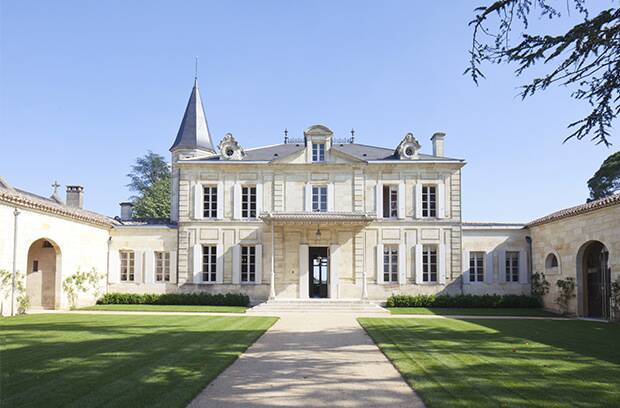
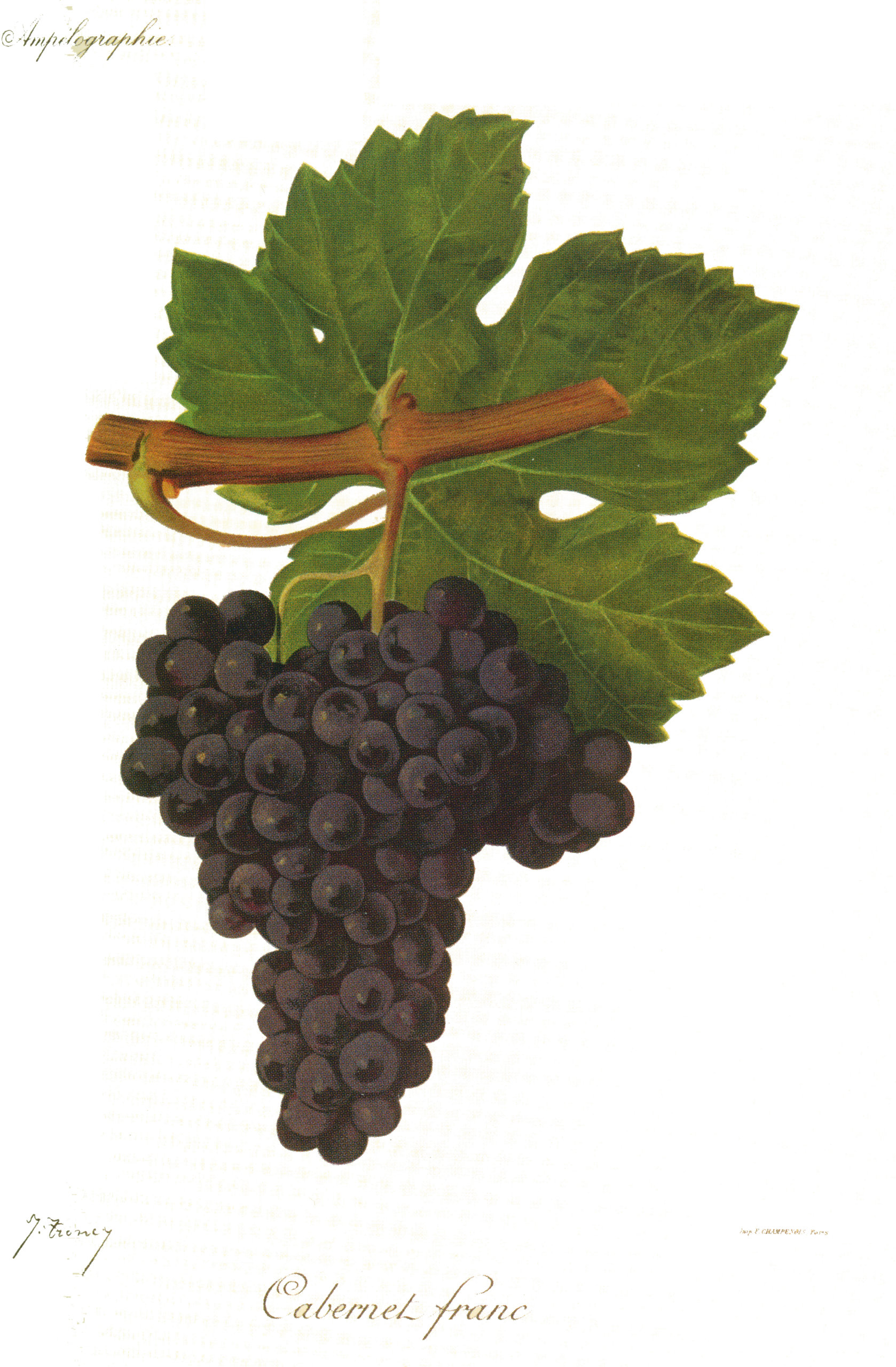
In France, as well as around the world, franc is widely planted, and no matter where, the fruit is more likely to end up in a blend, and typically as a lesser component, proportionally that is. The Bordeaux model, from either bank, has had the major influence on these planting and blending decisions in the new world. However, in the right conditions, franc is finding a singular voice, sometimes echoing styles of the Loire Valley, sometimes Bordeaux, and sometimes as individual expressions, expressive of place and maker rather than a benchmark.
There are also over 6,000 hectares of cabernet franc in Italy, though some vineyards have not properly identified whether the vines are franc, cabernet sauvignon or indeed carménère (an old Bordeaux grape that was thought to be merlot in Chile, and has since become that country’s defining grape), simply lumping them all together as cabernet. The Veneto is the most prolific home for franc, followed by Friuli-Venezia Giulia, then a smattering in Tuscany, with Bolgheri, on the coast, where it perhaps is accorded most acclaim, and mostly in Bordeaux blends.
Notable examples of 100 per cent cabernet franc are made in the Napa Valley, with Lang & Reid leading the way, but they are increasingly being joined by other makers. Superstar winemaker Aaron Pott has long been an advocate of cabernet franc, and with distinguished stints at leading Saint-Émilion estates, this is perhaps no surprise. And while his portfolio of Pott Wines is largely cabernet sauvignon, his 80 per cent franc ‘Space and Time’ is quite the cult wine.
Franc is proving successful in the cooler viticultural zones of the US, such as Virginia, Michigan and New York’s Finger Lakes, but it is not just succeeding for its earlier ripening properties, offering a somewhat different profile to cabernet sauvignon, and one that is proving to be worth celebrating. Indeed, franc is breaking free of its Bordeaux blend shackles, and the ever-more engaging reds of the Loire Valley are sketching out new possibilities, and ones that are proving inspirational in the new world.
In Australia, cabernet franc is planted in most regions where cabernet sauvignon is planted. But unlike cabernet sauvignon, which is Australia’s second most planted grape, occupying 24,682 hectares (last survey in 2015), franc only has 333 hectares devoted to it. While South Australia dominates the plantings of franc, varietal bottlings come from right across the country, with many notable examples coming out of Victoria and Western Australia. And cooler regions, with sites too cold for reliable cabernet sauvignon production, have proven to be excellent sources.
The Drogemuller family of Paracombe have been growing cabernet franc in the Adelaide Hills since 1983, and after tasting barrels to assemble wines from the 1993 vintage, they decided to release a varietal wine. Although franc has been grown in this country since James Busby first brought vines here in 1833, it’s fair to say that Paracombe have been a pioneer of bottling it solo.
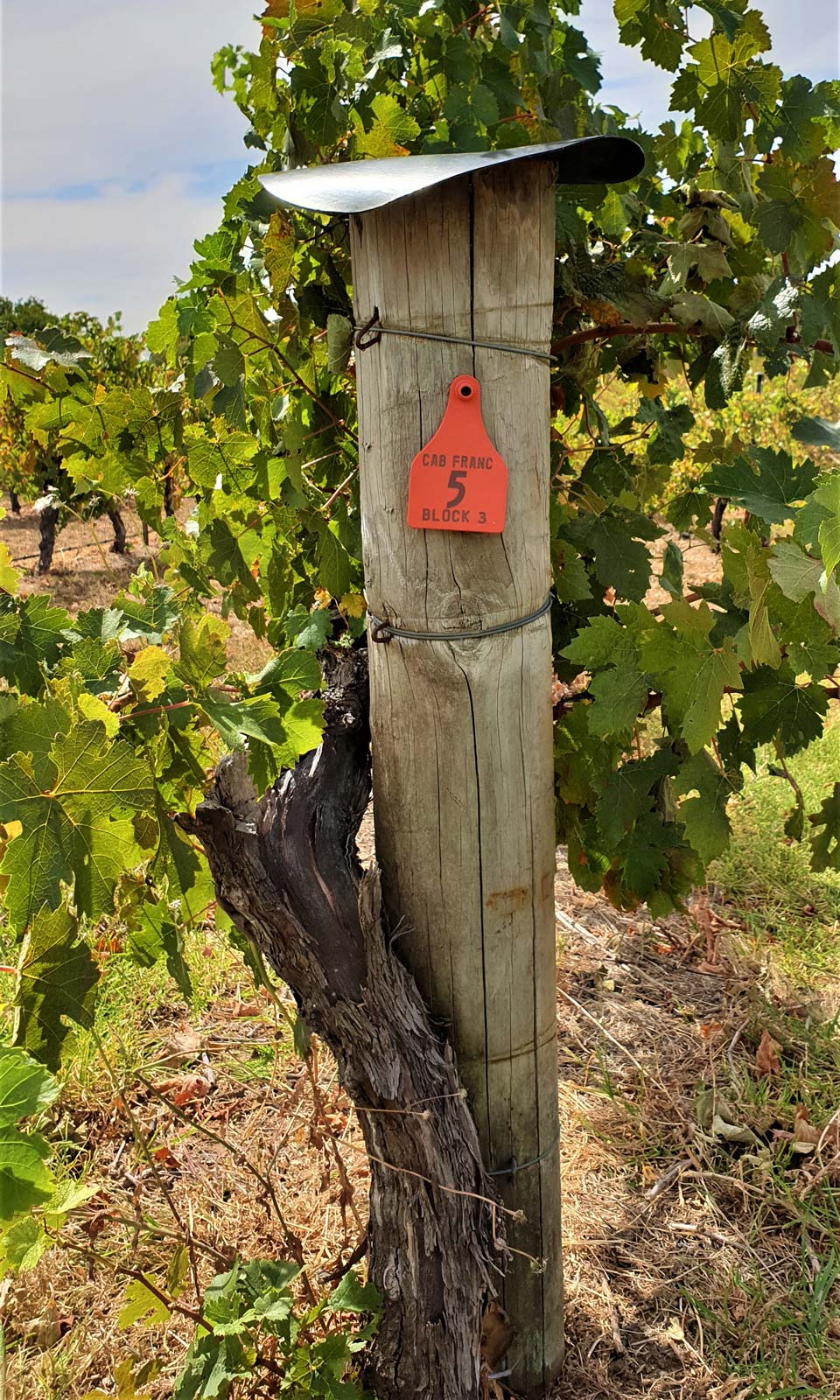

Michael Downer of Murdoch Hill has similarly been pursuing a Loire Valley style from the Adelaide Hills, with fragrance and poise at its core. While, in Wrattonbully, Xavier Bizot (of the Bollinger family, and Brian Croser’s son-in-law) has been producing a varietal cabernet franc from his close-planted Crayères Vineyard (planted in 2008), which has echoes of Bordeaux mingling with Loire Valley brightness.
In more traditional zones, like Coonawarra, makers like Leconfield work with lower levels of new oak than they do with cabernet sauvignon, but the results are very firmly in a classic cabernet mould, with Bordeaux the historic benchmark. While Mark Gifford’s Blue Poles in Margaret River takes its lead from Bordeaux’s Right Bank – which is unusual for the region – with a merlot and cabernet franc blend, ‘Allouran’, and a varietal bottling of each. Also in the west, AJ Hoadley of La Violetta makes a playfully aromatic, fragrant and textural cab franc, ‘Fric Frac’, from the Great Southern, which is recognisably varietal, but also thoroughly individual.
While the volume of cabernet franc planted in Australia put it on the edge of being a fringe variety already, the amount of wine bottled solo is really very modest. However, while low in volume, there has been a noticeable increase in varietal francs on the market, and the breadth of styles, from light and fragrant to powerful and imposing, immediately triggers the need for a Deep Dive.
So, with eight of this country’s best tasters in tow, we gathered every Australian example we could and put them under the microscope to find the wines that compelled the most. As usual, this was not an exercise in technical perfection or to champion one style over another, nor was it a search for profundity. Rather, the aim was to find wines of interest and character that reflected variety and place.
Franc shares much of its profile with cabernet sauvignon, just as a parent might with its progeny. But there are notable differences. While cabernet sauvignon is a late-ripening grape that can be marginal even in its most hallowed growing regions, franc ripens a good week earlier, providing a little insurance for those blending, and just being a little more reliable for those not. Franc tends to be less imposing than cabernet sauvignon, more fragrant with a less-pronounced tannin structure, and if pushed a little riper can be quite soft on the palate with pooling ripe fruit. Cabernet sauvignon typically has a little more of everything, but whether this makes it superior is a matter of opinion. In Bordeaux, where cabernet sauvignon may be nervy in a cool year, franc will soften the palate and add fragrance. The aromas are similar to cabernet sauvignon, with cassis, leaf, green pepper and tobacco notes, though many attribute raspberry and pepper to singling out franc, and Jancis Robinson notes that it often reminds her of pencil shavings.
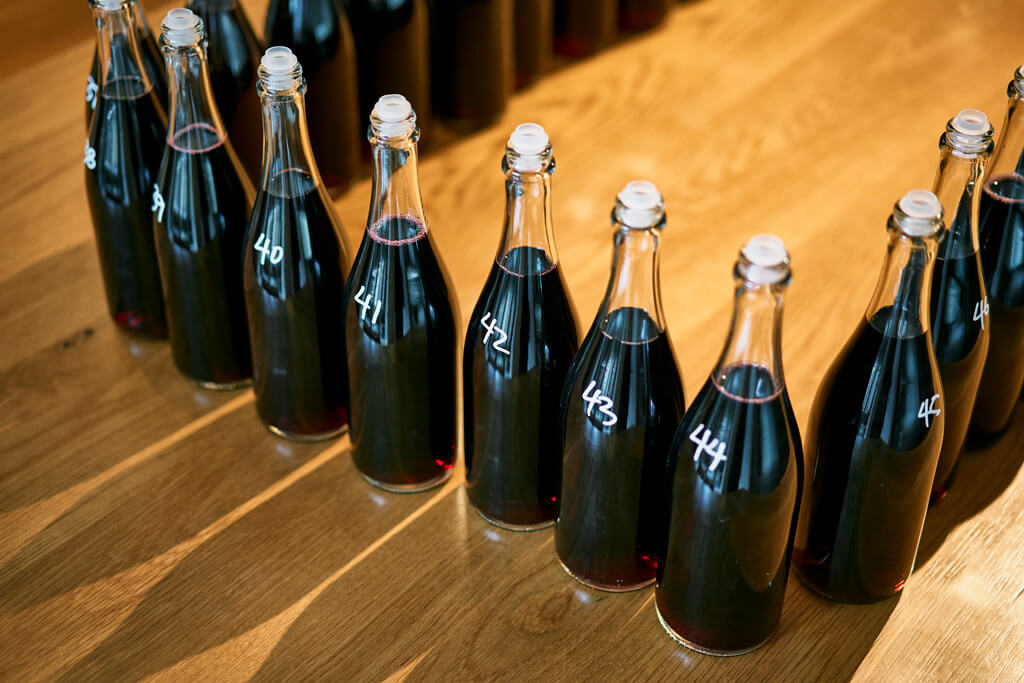

Our panel: Abhi Ayare, Sommelier, Reine & La Rue; Adeleine Zimmerman, WSET Educator; Ibrahim Khudeira, National Sales Manager, Foreign Fruits; Matthew Jensen, Group Sommelier, Renascence Group; Nicola Reid, Sommeliers Australia; Pierre Stock, PS Wine Selections; Sacha Imrie, Sommelier, Daughter In Law; Stuart Dudine, Winemaker, Alkimi Wines.
“I was very surprised by the quality of the winemaking but also the diversity in terms of style.” said Pierre Stock, opening the panel discussion, which came after the panel had spent the day tasting through the blind lineup of wines. “Not everything is very varietal but I suppose the terroir was speaking very much there – also the winemaking. So at the start it was very light very – nearly beajolais-esque – from this whole bunch and the carbonic maceration very lifted very parfumed very light very juicy. Towards the end you have all of those more wines that I would think probably benefits a bit of edging, so it’s a great great panel of really large diversity of wine that can actually really please everyone in Australia.”
Niocla Reid then replied, “I was sort of thinking that maybe I’d be leaning more towards the lighter styles – just because of my personal preferences – but actually there was some examples that had a little bit more structure and depth and breadth to them that I found myself really enjoying as well.
“The best examples were well-handled. they got the balance right between managing the varietal pyrazines and the nature of the variety and handling acidity, tannin, and those those structural elements and kind of making a harmonious core. Some really wonderful examples across the board.”
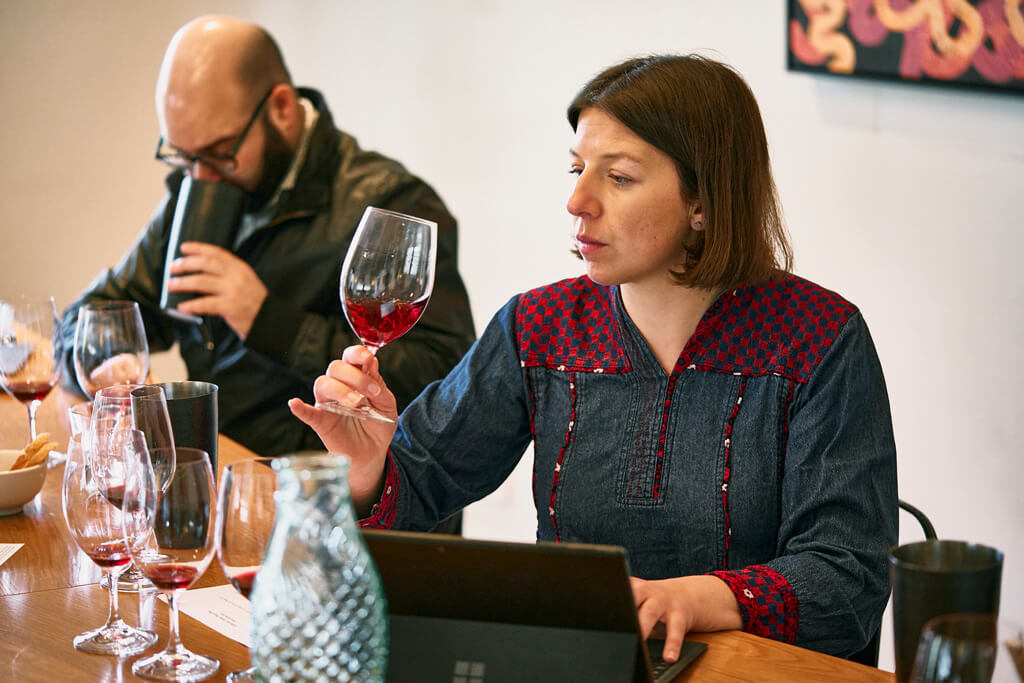
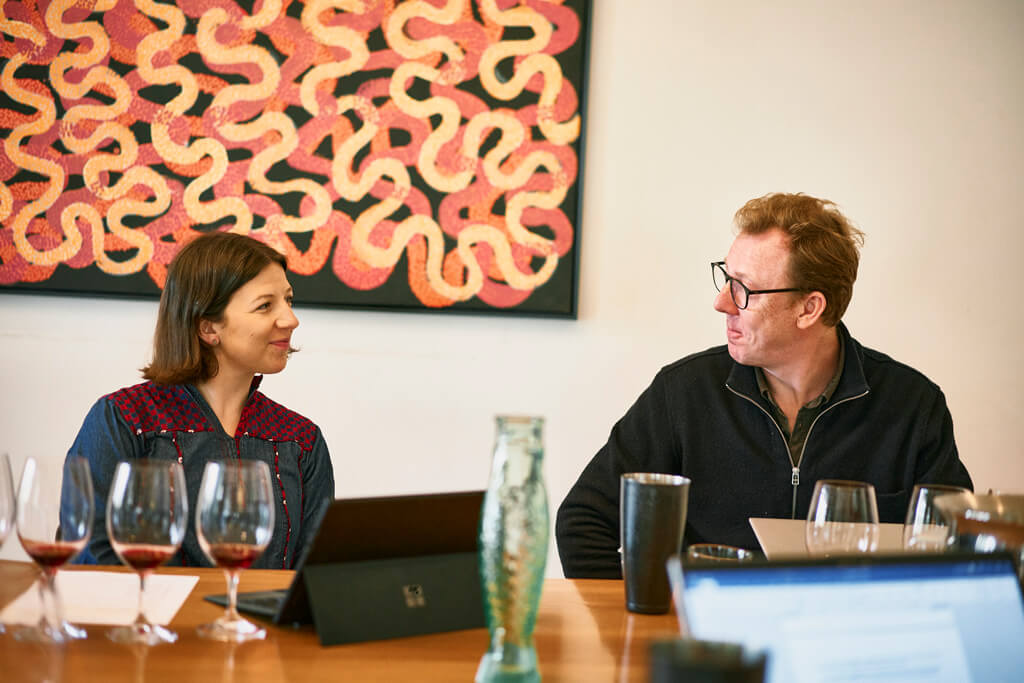
“From the lighter, more rosé-ish, light chilled red, to the more extracted or bigger, or mature – there is something for everyone.”
Adeline Zimmermann added: “For me, the purity of fruit, and the freshness and the vibrancy of all of those cabernets, it’s just amazing! Like Nicola, I love lighter styles but actually the balance between the tannins, the density with the extraction – from the lighter, more rosé-ish, light chilled red, to the more extracted or bigger, or mature – there is something for everyone and it’s actually a pretty crowd pleaser variety which I didn’t really expect.”
“I think Adeline hits it on the head,” declared Jensen, “Looking at this lineup, it’s changing my perception of how I might sell it. For instance – it’s not, ‘this is cabernet franc and this is what it’s going to look like.’ Because not a lot of those wines today are what I’d probably referred to as ‘typically cabernet franc’. There are so many different styles that you can look at the difference in the spectrum. For me, that’s the most surprising thing that I saw – that it wasn’t very varietal in terms of what I expected varietal to be. It tasted very Australian, I think.”
“I agree,” said Sacha Imrie, “It felt very Australiana – a lot of them, and a lot of unique characters. It didn’t feel like they were trying to be a wine from somewhere else. Like to be compared to a French cab franc. It felt very unique.”


Ibrahim Khudeira asked, “When you both say like it’s very Australia what does that mean to you?”
“When I think about cabernet franc as taught in WSET or CMS courses, you’re looking at a very specific style because that’s what those organisations see as being ‘varietally correct’,” replied Jensen. “I suppose there is that dryness, dusty tannin, that earthiness, that graphite, sour and dry cherries, because that’s what we’re told cabernet franc is supposed to be. And I suppose it’s why you don’t see many Australian wines put into blind tasting rounds because of the massive variety of styles that we have seen here today. The amount of time you stick your nose in a wine and that smells like a eucalyptus tree. That is a very distinctive Australian flavour service – especially for something like this. I wouldn’t expect to see that in what we considered to be classically French, I suppose. That, and a lot juicier – there’s a lot more extraction in a lot of these wines than you might normally see as well.”
“Quite a creamy and viscous texture in a lot of them and jubey,” Imrie added, “I feel like there’s a bit more architecture in cabernet francs from abroad.”
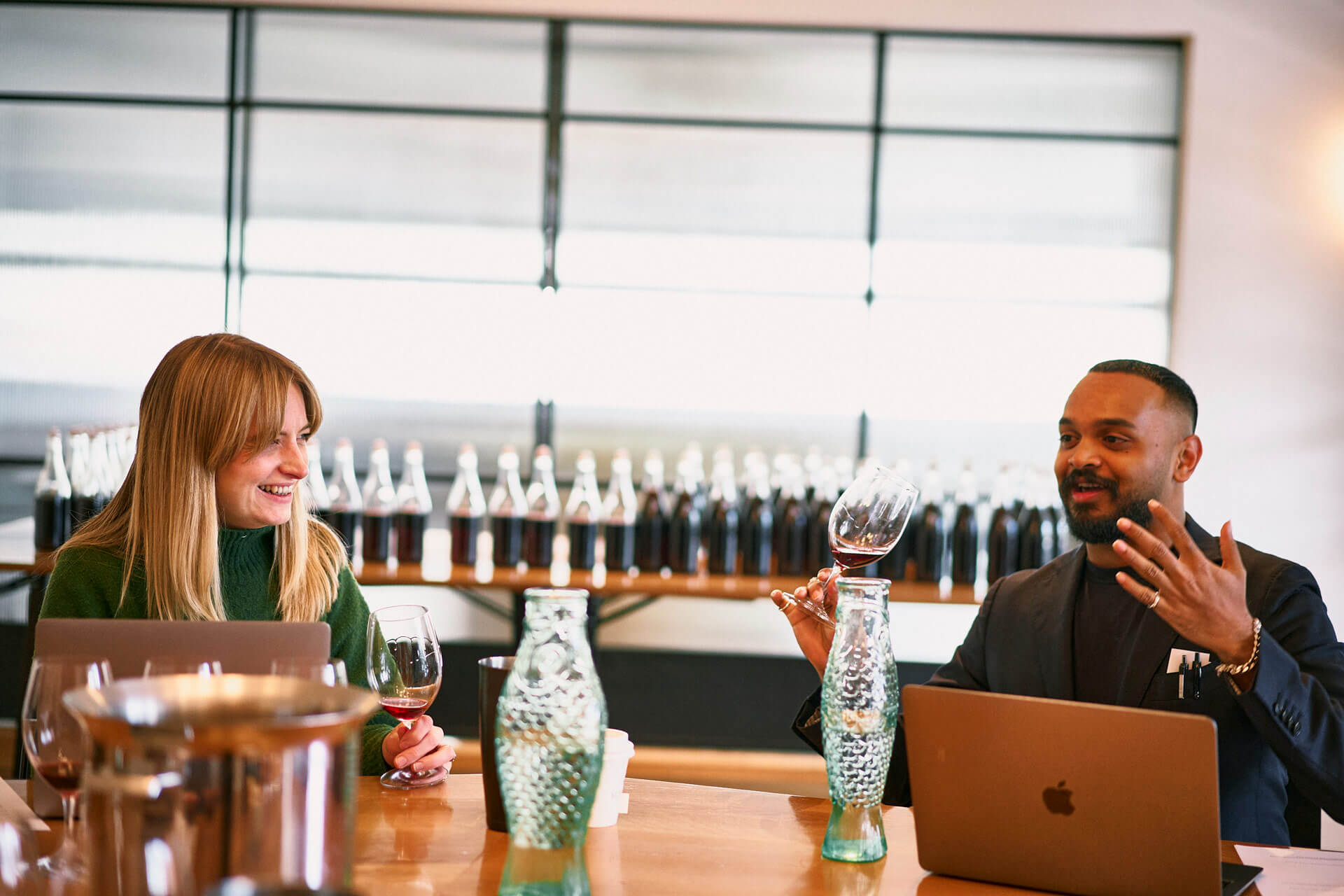

“The terroir is so evident.”
Stuart Dudine turned to his perspective as a winemaker. “I think one of the really interesting things and sort after things about cab franc is that it is a variety that can be kind of played with in the winery – from whole bunch, use of oak, to time on skins, or picking it early versus picking it late – it’s quite adaptable to a lot of different kind of techniques and they’ve all been incredibly well handled,” he said. “We didn’t really see any kind of artefact that was sticking out – there wasn’t too much oak, there wasn’t too much whole bunch, there wasn’t too much extraction – they’ve all been incredibly well handled. Great concentration in a lot of them too. It was a real pleasure to have a look at these wines.
“It’s one of those things, that you kind of think cab franc is traditionally used as a blending variety in Bordeaux and you have to go to really unique spots like the Loire and maybe sometimes Bolgheri in Italy, but yes it’s quite rare to see a cab franc as a standalone but it just goes to show that cab franc can be a standalone variety in its own right when it’s when it’s handled exceptionally well like the lineup today has demonstrated.”

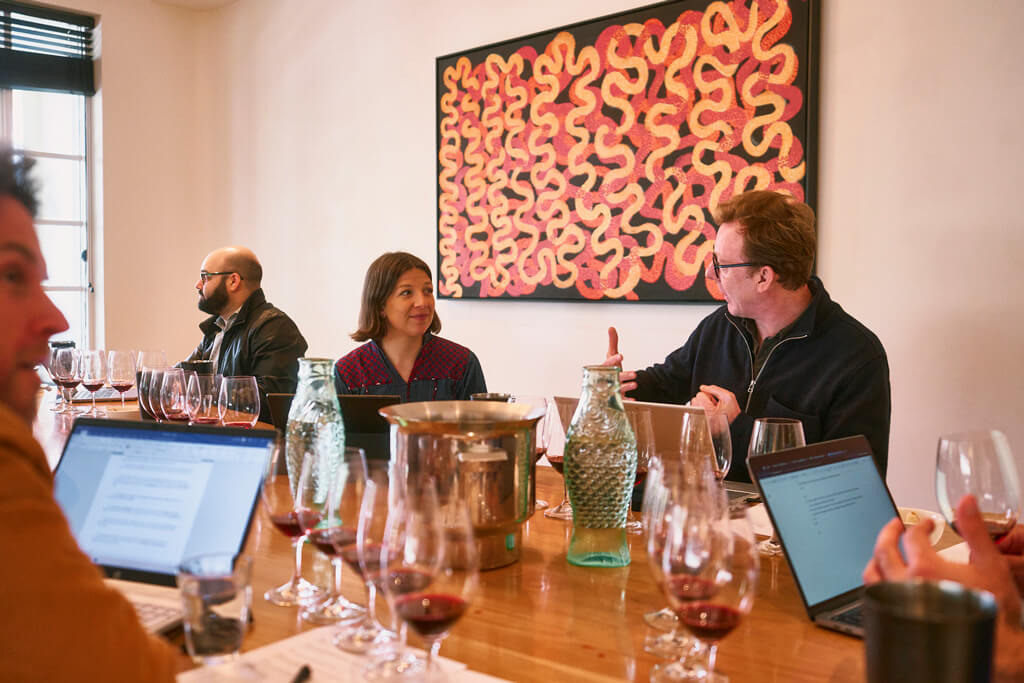
“I felt pretty much most of the tasting today I was not in the Loire at all,” said Pierre Stock. “I felt like I was in the Beajolais, then some part of the Rhone Valley, and then moving to the Bordeaux area.”
“In a restaurant setting,” said Abhi Ayare, “When recommending a wine to a customer, it can be pitched as a very good diversion from say Beaujolais or gamay.”
Digging into the theme of regionality with wine, Khudeira referenced the sense of terroir in the wines today, “For each one of the wines that ended up on my top-six, I wrote about the soil type that I think it is based on the structure.” Being a blind tasting, the provenance of the wines was unknown at the time of the discussion. “It’ll be really interesting to find out the regions and soil types and discovering where the variety may be best suited in Australia.”
Stock agreed: “I felt on so many occasions yeah there is granite, yes there is sand, yes there is more clay or… I really felt big difference between some of the wines, which is really great because in Australia we always talk about varietal. We never talk too much about terroir, and the terroir is so evident. If we can start to talk about terroir in Australia then we’re going to start to see great wine because it’s literally where things grow so it’s the most important things.”
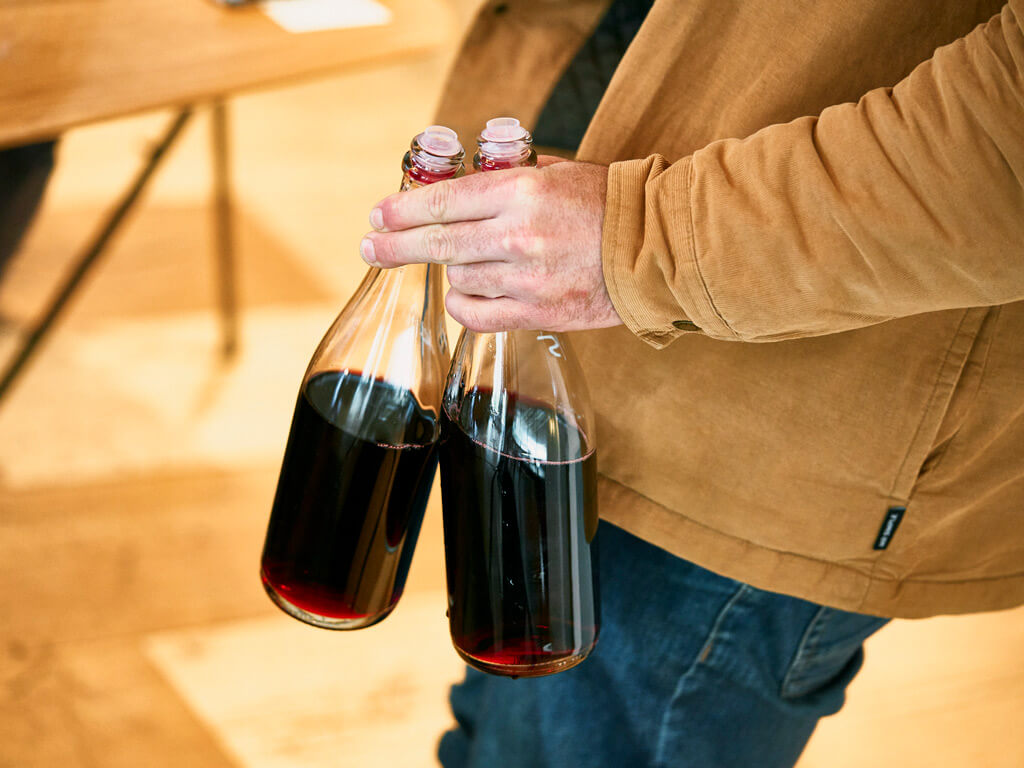
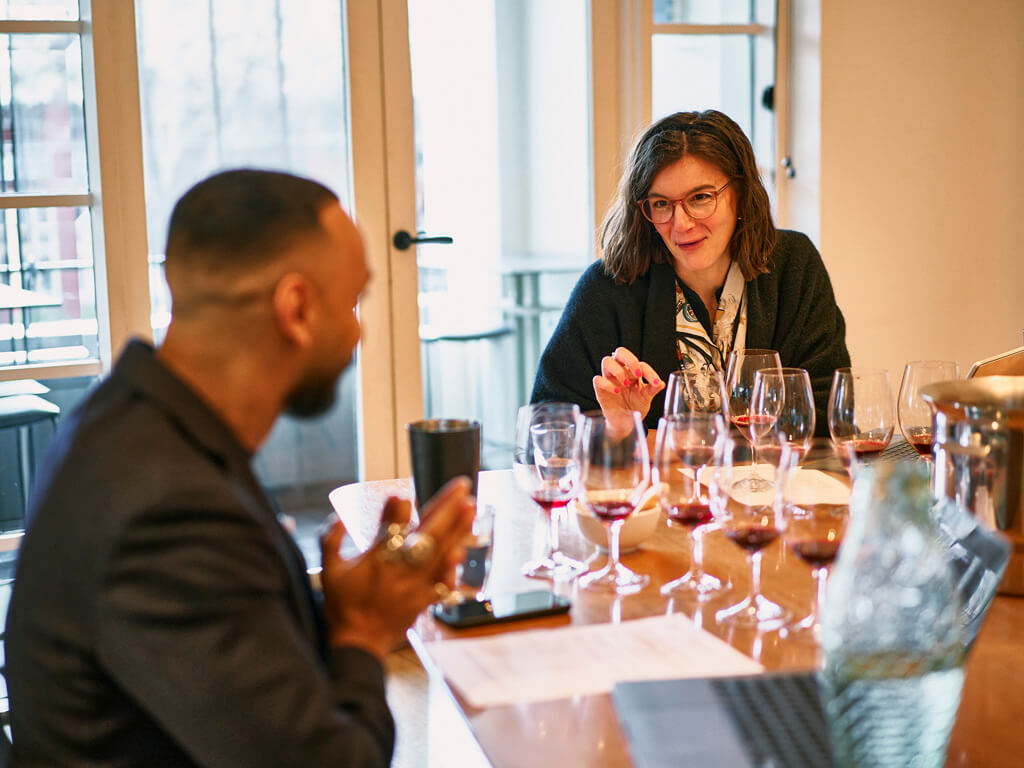
Nicola Reid teaches WSET Levels 2, 3, and Diploma at Prince Wine Store and serves as the Executive Officer at Sommeliers Australia. After earning a Politics and Spanish degree from the University of Bristol, she worked as a sommelier at Hampton Manor in the UK, before gaining her Yachtmaster qualifications and working on luxury sailing yachts across the globe. Nicola has completed four vintages as a Cellar Hand in England and Australia, and spent six years with The Spanish Acquisition, a leading Australian importer of Iberian wines. She is also a WSET Diploma graduate, awarded the John Avery Vintners’ Bursary.
Pierre Stock has worked extensively in Australia and Europe as a restaurant manager, waiter and sommelier, including at the iconic three-Michelin-starred Paul Bocuse and London’s much-loved Racine and La Caprice. In Melbourne, before almost a decade working as a sommelier and curating the wine list at South Yarra’s legendary France-Soir, Stock was the restaurant manager and event director at Pearl and Vue de Monde respectively. He is the owner and director of PS Wine Selections, an importing, wholesale and direct wine retail business.
Sacha Imrie is the sommelier at Daughter in Law, Melbourne. She began her career at 14, working in her uncle’s restaurant, Hewat’s, in Edinburgh, while studying for a BA Hons in Sculpture at Edinburgh College of Art. During this time, she also completed the WSET Level 3 wine qualification and worked at a local French wine bar and bistro. Intrigued by Melbourne’s hospitality scene, Imrie moved there and never looked back. In Melbourne, she held roles with Bomba and worked as a sommelier and buyer for the McConnell Group, covering Gertrude St venues The Builders Arms, Marion, and Cutler and Co from 2015 to 2019. In 2019, Imrie, her husband, and their business partners opened Daughter in Law Melbourne, followed by Daughter in Law Adelaide in 2021, Pinky Ji Sydney in 2023, Bibi Ji Melbourne in 2024, and their newest venture, The Daughter’s Arms at Ovolo Hotel, opening this week. Imrie also has her own wine range, Hey Tomorrow, featuring winemaker collaborations in cask packaging. The project won the Victorian Premier’s Communication Design Award in 2022.
Abhi Ayare is the Assistant Head Sommelier at the renowned Reine and La Rue in Melbourne. Originally from Mumbai, Abhi moved to Australia seven years ago, quickly making a name for himself at some of Sydney’s top venues. Most recently, he served as the Precinct Head Sommelier for Charles Grand Brasserie, The Charles Bar, and Tiva Lounge, and held key roles at Mimi’s, Woodcut, and the Park Hyatt Sydney. At just 21, Abhi became the youngest-ever Dux for the Certified Sommelier program. A year later, at 22, he made history as the world’s youngest Advanced Sommelier through the Court of Master Sommeliers. He is now on the path to pursuing the prestigious Master Sommelier Diploma.
Adeline Zimmermann has been immersed in the wine industry from an early age, learning integral aspects of the business at her family’s Domaine (est. 1693), in Alsace. After working in Burgundy, Adeline moved to London to work for Wine Australia. She completed her Masters of International Business in China, where she focused on the Chinese perception of French wines. Adeline is a WSET Diploma holder and a WSET educator. She is currently a Master of Wine student. Adeline is the Australia, New Zealand and Pacific Islands Export Manager for Barton & Guestier, Listel and Patriarch.
Matthew Jensen is the Group Sommelier at Renascence Group, overseeing the wine programs for Farmer’s Daughters, Victoria by Farmer’s Daughters, and Morena. After completing a degree in journalism and political science, Jensen discovered his passion for wine while working in a wine store, where he enjoyed combining his love for wine with engaging conversations. He holds certifications from the Court of Master Sommeliers and WSET Level 3. Jensen’s career includes notable roles such as Assistant Head Sommelier at Vue de Monde and Head Sommelier at Atlas Dining.
Stuart Dudine is the owner and winemaker of Alkimi Wines, which he founded in 2014. Since 2016, he has also served as the Senior Contract Winemaker for Kellybrook Winery in the Yarra Valley. Stuart graduated with a Wine Science degree from Charles Sturt University in 2010, after completing his first vintage in 2006. His winemaking approach has been shaped by experience at Henschke, Yarra Yering, Mac Forbes, and internationally in Piedmont, Austria’s Wachau, and most notably, the Rhône Valley—both in the north (Côte-Rôtie) and the south (Châteauneuf-du-Pape). These experiences deeply influenced the style of his first Alkimi wines.
Ibrahim Khudeira is the National Sales Manager for Foreign Fruits, an importer and distributor of European wines, and has been with the DITC Group since 2020. He entered the wine industry through hospitality, quickly becoming the venue manager at The Alps Wine Shop & Bar. Before helping establish Foreign Fruits, Ibrahim managed and sourced wines for DITC’s online retail business, Diggin’ in the Cellars. His passion for wine has also led him to participate in two recent vintages at Syrahmi in Heathcote.
Please sign in or create account as candidate to bookmark this job
Please sign in or create account to save this search

Please sign in or create account as candidate to create a resume